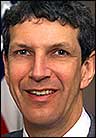At last week’s EPC Connection 2008 conference in Chicago, Carolyn Walton, VP of information systems for Wal-Mart Stores, and Alan Estevez, principal assistant deputy undersecretary of defense for the U.S. Department of Defense (DOD), both reaffirmed their organizations’ commitment to deploying RFID technology, asserting that their respective efforts are not losing steam.
At a panel discussion moderated by RFID Journal founder and editor Mark Roberti, Walton said she’d anticipated being questioned about her company’s resolve, and offered a rundown on the status of the retailer’s RFID deployment: About 1,300 of the Wal-Mart and Sam’s Club stores her company operates within the United States, she said—about one third of its total U.S. locations—are RFID-enabled, as are several distribution centers, “so expansion is continuing.”
At last year’s EPC Connection conference, Walton unveiled a new, three-pronged deployment strategy the retailer had devised to home in on where it perceived the most value in receiving RFID-tagged products (see Wal-Mart, Sam’s Club Push RFID Further Along). One part of this strategy was to begin asking suppliers for Wal-Mart stores to tag cases of items in specific categories, because a pilot project bore this out as being a particularly good means of improving sales across such categories by ensuring better inventory accuracy (see Wal-Mart-Commissioned Study Shows RFID Improves Store Inventory Accuracy).
Walton also announced, at last week’s conference, that Wal-Mart plans to continue rolling out this targeted tagging initiative. “Our next move will be to expand tagging in 13 product categories across seven departments, tagging at the case level,” she said. The products will range widely in type, she added—”everything from toys to home furnishings.” According to Walton, select suppliers will begin tagging cases in these product categories starting next month, with more suppliers set to be added throughout the end of the year.
In addition, Walton told attendees that her company has created a special council of Sam’s Club suppliers with whom it plans to share metrics and other data regarding the deployment of RFID tracking in Sam’s Club stores. These suppliers will receive this information before it is publicly disseminated.
Estevez provided an update on the DOD’s deployment of its passive RFID mandate, saying the department recorded 180,000 tag reads last month—a 40 percent increase from one year ago—across all of the Defense Logistics Agency‘s RFID-enabled depots, which consist of all 17 of its continental U.S. depots and two of its eight overseas, including one at Pearl Harbor, where the Navy and Marines currently employ RFID to track commodities and assets (see Navy, Marines Track Assets on Oahu).
“We have not backed off at all,” Estevez said. “We are making sustained progress.” However, he noted, funds for expanding the RFID system—to do things such as establish an EPCIS-based data-sharing system to let supplies know when their tagged shipments have arrived—are difficult to allocate, given the attention the federal government must place on the country’s financial systems.
Still, Estevez said, the RFID system has allowed the DLA to correlate advance shipment notices with tag reads at the depots, in order to reconcile orders with receipts and expedite payments to suppliers applying tags. In addition, he said, the department has made progress in adding RFID tagging clauses to supplier contracts, “despite” findings in a recent report issued by the DOD’s Office of the Inspector General (see Needs to Enforce Its Own RFID Mandate, Says Inspector General). That report recommended that the department do more to ensure it reaps a return on its RFID investment.
“You could say that 10 percent of [contracts] are not complying, rather than say that 90 percent are—it depends on how you look at it,” Estevez stated, referencing one of the report’s findings: that of 220 audited supply contracts, 23—or 10 percent—failed to include a clause requiring that goods be tagged before being shipped to RFID-enabled depots.
When asked if they were satisfied with their respective RFID rollouts, both Walton and Estevez said they were not, inasmuch as being satisfied meant meeting all of their program objectives. “I don’t think satisfaction is a word I use in Wal-Mart culture,” Walton said. “We continually reassess. It [the RFID rollout] is a journey, and we have made significant steps, but we’re not done and I don’t know that we ever will be. We’ll always be looking for ways to lower prices.”



